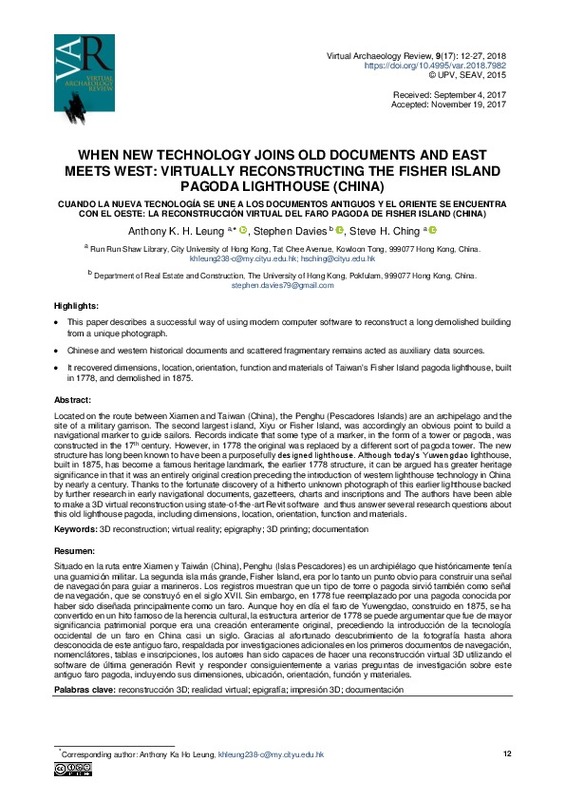JavaScript is disabled for your browser. Some features of this site may not work without it.
Buscar en RiuNet
Listar
Mi cuenta
Estadísticas
Ayuda RiuNet
Admin. UPV
When new technology joins old documents and east meets west: virtually reconstructing the Fisher Island Pagoda Lighthouse (China)
Mostrar el registro completo del ítem
Leung, AK.; Davies, S.; Ching, SH. (2018). When new technology joins old documents and east meets west: virtually reconstructing the Fisher Island Pagoda Lighthouse (China). Virtual Archaeology Review. 9(18):12-27. https://doi.org/10.4995/var.2018.7982
Por favor, use este identificador para citar o enlazar este ítem: http://hdl.handle.net/10251/94442
Ficheros en el ítem
Metadatos del ítem
| Título: | When new technology joins old documents and east meets west: virtually reconstructing the Fisher Island Pagoda Lighthouse (China) | |
| Otro titulo: |
|
|
| Autor: | Leung, Anthony K.H. Davies, Stephen Ching, Steve H. | |
| Fecha difusión: |
|
|
| Resumen: |
[EN] Located on the route between Xiamen and Taiwan (China), the Penghu (Pescadores Islands) are an archipelago and the site of a military garrison. The second largest island, Xiyu or Fisher Island, was accordingly an ...[+]
[ES] Situado en la ruta entre Xiamen y Taiwán(China), Penghu (Islas Pescadores) es un archipiélago que históricamente tenía una guarnición militar. La segunda isla más grande, Fisher Island, era por lo tanto un punto obvio ...[+]
|
|
| Palabras clave: |
|
|
| Derechos de uso: | Reconocimiento - No comercial - Sin obra derivada (by-nc-nd) | |
| Fuente: |
|
|
| DOI: |
|
|
| Editorial: |
|
|
| Versión del editor: | https://doi.org/10.4995/var.2018.7982 | |
| Agradecimientos: |
The lead author is grateful for support from Prof. Steve Ching and Prof. Stephen Davies during the exercise. We also owe a debt of thanksto support from The Royal Geographical Society Picture Library ...[+]
|
|
| Tipo: |
|








